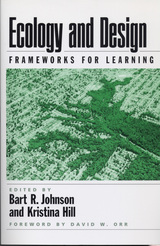
The vision of a garden shared peacefully by humans and animals is a familiar, but elusive, landscape trope. Whether threatened by habitat destruction or climate change, displaced by urbanization or invasive species, poisoned by industrial toxins, or hunted to extinction, many wild animals have failed to thrive in the company of people. There is growing scientific consensus that we are in the midst of the sixth great extinction in earth history—and the first caused by human activities.
What agency can landscape architects and garden designers have in conserving or restoring wildlife diversity? Designing Wildlife Habitats gathers essays by designers, scientists, and historians to explore how they might better collaborate to promote zoological biodiversity and how scientific ambitions might be expressed in culturally significant and historically informed design. Established conservation practices within ecology have begun to shape landscape architecture, and current initiatives in ecosystem services, restoration ecology, and designer-generated ecological experiments provide an enlarged role for landscape architects in the creation of productive habitats. Design has become increasingly instrumental to both the appearance and the ecological function of landscapes.

Professionals, faculty, and students are aware of the pressing need to integrate ecological principles into environmental design and planning education, but few materials exist to facilitate that development.
Ecology and Design addresses that shortcoming by articulating priorities and approaches for incorporating ecological principles in the teaching of landscape design and planning. The book explains why landscape architecture and design and planning faculty should include ecology as a standard part of their courses and curricula, provides insights on how that can be done, and offers models from successful programs. The book:
- examines the need for change in the education and practice of landscape architecture and in the physical planning and design professions as a whole
- asks what designers and physical planners need to know about ecology and what applied ecologists can learn from design and planning
- develops conceptual frameworks needed to realize an ecologically based approach to design and planning
- offers recommendations for the integration of ecology within a landscape architecture curriculum, as an example for other design fields such as civil engineering and architecture
- considers the implications for professional practice
- explores innovative approaches to collaboration among designers and ecologists
In addition to the editors, contributors include Carolyn Adams, Jack Ahern, Richard T. T. Forman, Michael Hough, James Karr, Joan Iverson Nassauer, David Orr, Kathy Poole, H. Ronald Pulliam, Anne Whiston Spirn, Sandra Steingraber, Carl Steinitz, Ken Tamminga, and William Wenk. Ecology and Design represents an important guidepost and source of ideas for faculty, students, and professionals in landscape architecture, urban design, planning and architecture, landscape ecology, conservation biology and restoration ecology, civil and environmental engineering, and related fields.
READERS
Browse our collection.
PUBLISHERS
See BiblioVault's publisher services.
STUDENT SERVICES
Files for college accessibility offices.
UChicago Accessibility Resources
home | accessibility | search | about | contact us
BiblioVault ® 2001 - 2024
The University of Chicago Press









